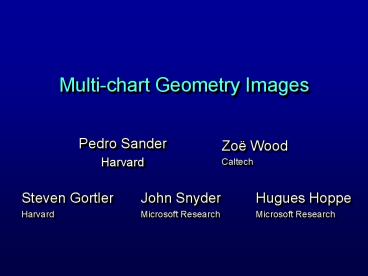Multichart Geometry Images PowerPoint PPT Presentation
Title: Multichart Geometry Images
1
Multi-chart Geometry Images
- Pedro Sander
- Harvard
Zoë Wood Caltech
Hugues Hoppe Microsoft Research
Steven Gortler Harvard
John Snyder Microsoft Research
2
Geometry representation
semi-regular
irregular
completely regular
3
Basic idea
cut
parametrize
4
Basic idea
cut
sample
5
Basic idea
cut
store
simple traversal to render
r,g,b x,y,z
6
Benefits of regularity
- Simplicity in rendering
- No vertex indirection
- No texture coordinate indirection
- Hardware potential
- Leverage image processing tools for geometric
manipulation
7
Limitations of single-chart
long extremities
high genus
? Unavoidable distortion and undersampling
8
Limitations of semi-regular
Base charts effectively constrained to be
equal size equilateral triangles
9
Multi-chart Geometry Images
piecewise regular
400x160
irregular
10
Multi-chart Geometry Images
- Simple reconstruction rulesfor each 2-by-2 quad
of MCGIM samples - 3 defined samples ? render 1 triangle
- 4 defined samples ? render 2 triangles
(using shortest diagonal)
11
Multi-chart Geometry Images
- Simple reconstruction rulesfor each 2-by-2 quad
of MCGIM samples - 3 defined samples ? render 1 triangle
- 4 defined samples ? render 2 triangles
(using shortest diagonal)
12
Cracks in reconstruction
- Challenge the discrete sampling will cause
cracks in the reconstruction between charts
zippered
13
MCGIM Basic pipeline
- Break mesh into charts
- Parameterize charts
- Pack the charts
- Sample the charts
- Zipper chart seams
- Optimize the MCGIM
14
Mesh chartification
- Goal planar charts with compact boundaries
- Clustering optimization - Lloyd-Max (Shlafman
2002) - Iteratively grow chart from given seed
face.(metric is a product of distance and
normal) - Compute new seed face for each chart.(face that
is farthest from chart boundary) - Repeat above steps until convergence.
15
Mesh chartification
- Bootstrapping
- Start with single seed
- Run chartification using increasing number of
seeds each phase - Until desired number reached
demo
16
Chartification Results
- Produces planar charts with compact boundaries
Sander et. al. 2001 80 stretch efficiency
Our method 99 stretch efficiency
17
Parameterization
- Goal Penalizes undersampling
- L2 geometric stretch of Sander et. al. 2001
- Hierarchical algorithm for solving minimization
18
Parameterization
- Goal Penalizes undersampling
- L2 geometric stretch of Sander et. al. 2001
- Hierarchical algorithm for solving minimization
Angle-preserving metric (Floater)
19
Chart packing
- Goal minimize wasted space
- Based on Levy et al. 2002
- Place a chart at a time (from largest to
smallest) - Pick best position and rotation (minimize
wasted space) - Repeat above for multiple MCGIM rectangle shapes
- pick best
20
Packing Results
Levy packing efficiency 58.0
Our packing efficiency 75.6
21
Sampling into a MCGIM
- Goal discrete sampling of parameterized charts
into topological discs - Rasterize triangles with scan conversion
- Store geometry
22
Sampling into a MCGIM
Boundary rasterization
Non-manifold dilation
23
Zippering the MCGIM
- Goal to form a watertight reconstruction
24
Zippering the MCGIM
- Algorithm Greedy (but robust) approach
- Identify cut-nodes and cut-path samples.
- Unify cut-nodes.
- Snap cut-path samples to geometric cut-path.
- Unify cut-path samples.
25
Zippering Snap
- Snap
- Snap discrete cut-path samples to geometrically
closest point on cut-path
26
Zippering Unify
- Unify
- Greedily unify neighboring samples
27
How unification works
- Unify
- Test the distance of the next 3 moves
- Pick smallest to unify then advance
28
How unification works
- Unify
- Test the distance of the next 3 moves
- Pick smallest to unify then advance
29
How unification works
- Unify
- Test the distance of the next 3 moves
- Pick smallest to unify then advance
30
Geometry image optimization
- Goal align discrete samples with mesh features
- Hoppe et. al. 1993
- Reposition vertices to minimize distance to
the original surface - Constrain connectivity
31
Multi-chart results
genus 2 50 charts
478x133
Rendering PSNR 79.5
32
Multi-chart results
RenderingPSNR 75.6
genus 1 40 charts
174x369
33
Multi-chart results
RenderingPSNR 84.6
genus 0 25 charts
281X228
34
Multi-chart results
RenderingPSNR 83.8
genus 0 15 charts
466x138
35
Multi-chart results
irregularoriginal
singlechart PSNR 68.0
multi-chart PSNR 79.5
478x133
demo
36
Comparison to semi-regular
Original irregular
Semi-regular
MCGIM
37
Comparison to semi-regular
Original irregular mesh
Semi-regular mesh PSNR 87.8
MCGIM mesh PSNR 90.2
38
Summary
- Contributions
- Overall MCGIM representation
- Rendering simplicity
- Major zippering and optimization
- Minor packing and chartification
39
Future work
- Provide
- Compression
- Level-of-detail rendering control
- Exploit rendering simplicity in hardware
- Improve zippering

